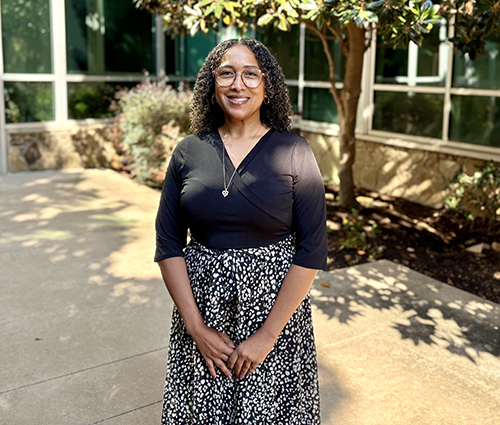SOUTHLAKE, Texas — She could feel the excitement from the surrounding runners at the starting line. Months of training – on and off the pavement – had led to this moment. Krishara Alexander, 46, started the race off strong but she could feel each mile, from the ground to her hips, while running her first half-marathon. Alexander didn’t know it yet, but this would be her last race for a while.
“I just worked through the pain and kept going,” Alexander said. “Honestly, I thought the aches and pain were just a part of getting older.”
Sports had always been a big part of Alexander’s life. She competed in gymnastics as a young child and continued it through high school. Like many people during the COVID pandemic, she decided to try something new – running.

“I have four children and wanted to stay active to keep up with them,” Alexander said with a chuckle.
After completing the half-marathon, Alexander thought she could just push through the pain, so she started training for a full marathon, 26.2 miles, the following year. Her body had a different plan though.
“My hip pain got worse, even to the touch,” she said. “It was to the point that I couldn’t get fancy with dinner. Standing on my feet too long, even to cook a meal, just wiped me out.”
Alexander’s primary care doctor recommended she see an orthopedist.
“Hip issues are fairly common with active adults, ages 40-60,” said Katherine C. Bartush, M.D., an orthopedic surgeon on the medical staff at Texas Health Harris Methodist Hospital Southlake. “This can happen when people do repetitive activities. I see it in athletes, specifically with running and jumping.”
Runners can also suffer from tendonitis, bursitis, bone contusions or bone bruises and stress injuries.
An MRI revealed that Alexander had inflammation and partial tearing in the gluteus medius, a muscle on the side of the hip that helps stabilize the pelvis and controls hip movement during activities like walking and standing. She was also diagnosed with greater trochanter bursitis on the outside of her left hip. The painful condition often is due to irritation or inflammation of the tendons or muscles around the thigh bone.
Alexander started physical therapy and received a steroid shot. She also discussed other treatment options, including acupuncture, platelet-rich plasma (PRP) injections, as well as modified workouts.
“The pain never went away, and I decided surgery was the next step,” Alexander said.
Last November, Bartush performed an endoscopic gluteus medius repair, a minimally invasive procedure in which small incisions are made near the hip joint to remove inflammation.
“By removing the inflammation, patients experience less pain. We also directly visualize the muscle and perform a repair,” Bartush said. “The goal of the recovery process is to protect the surgical site and develop the surrounding muscles, so you could go on to be a much better athlete after surgery.”
Alexander called her recovery “seamless,” with minimal swelling and minimal pain. This time, she was eager to begin physical therapy, knowing she was on the right path.
Nearly two months after surgery, she started strength training again and eventually felt strong enough for a slow jog.
She’s now counting down the weeks and days to her one-year “surgeryversary.”
“Come November, I think I’ll feel mentally and physically ready to start training for another race,” Alexander said.
Related News
About Texas Health Resources
Texas Health Resources is a faith-based, nonprofit health system that cares for more patients in North Texas than any other provider. With a service area that consists of 16 counties and more than 8 million people, the system is committed to providing quality, coordinated care through its Texas Health Physicians Group and 29 hospital locations under the banners of Texas Health Presbyterian, Texas Health Arlington Memorial, Texas Health Harris Methodist and Texas Health Huguley. Texas Health access points and services, ranging from acute-care hospitals and trauma centers to outpatient facilities and home health and preventive services, provide the full continuum of care for all stages of life. The system has more than 4,400 licensed hospital beds, 6,400 physicians with active staff privileges and nearly 29,000 employees. For more information about Texas Health, call 1-877-THR-WELL, or visit www.TexasHealth.org.
